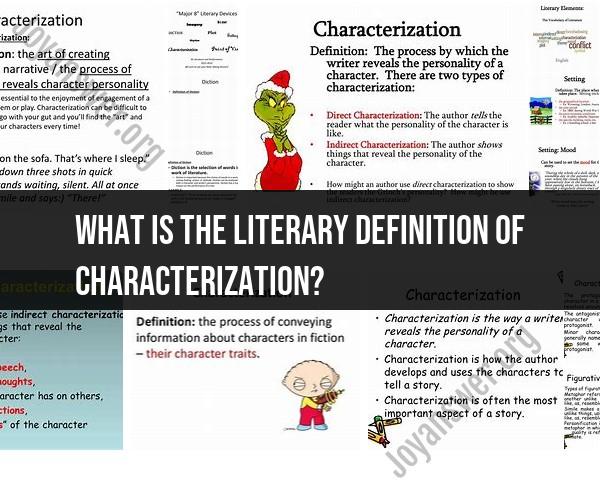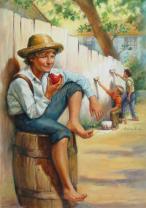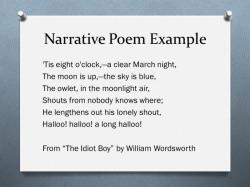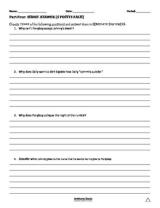What is the literary definition of characterization?
In literature, characterization refers to the process by which an author develops and portrays the personalities of the characters in a story. It involves creating and revealing the traits, motivations, beliefs, and behaviors of the characters to make them more vivid and believable to the reader. Characterization is a fundamental aspect of storytelling and is essential for readers to connect with and understand the characters in a narrative.
There are two primary methods of characterization:
Direct Characterization: This occurs when the author explicitly states or describes a character's traits, qualities, or attributes. For example, the author may directly say, "She was a kind and generous person."
Indirect Characterization: This involves revealing a character's traits through their actions, thoughts, speech, appearance, and how other characters in the story react to them. Readers must infer or deduce the character's qualities from these indirect cues. For example, if a character regularly helps others and speaks compassionately, the reader may infer that the character is kind.
Authors use both direct and indirect characterization to provide depth and complexity to their characters. Effective characterization makes characters more relatable, memorable, and multi-dimensional, allowing readers to engage more deeply with the narrative and its themes. It helps readers understand the characters' motivations and how they evolve over the course of the story, which is crucial for a story's overall impact.
Literary Definition of Characterization: Insights and Examples
Characterization is the process by which a writer reveals the personality of a character. It is one of the most important elements of fiction, as it helps readers to connect with the characters and understand their motivations.
There are two main types of characterization: direct and indirect. Direct characterization is when the author tells the reader directly about the character's personality. For example, the author might say, "Sarah was a kind and compassionate person." Indirect characterization is when the author shows the reader the character's personality through their actions, speech, and relationships with other characters. For example, the author might describe Sarah volunteering at a soup kitchen or helping an elderly neighbor with her groceries.
Here are some examples of characterization from literature:
- In Pride and Prejudice, Jane Austen uses direct characterization to describe Elizabeth Bennet: "Elizabeth was the second eldest of five daughters, a lively, quick-witted girl, who had read much and thought more."
- In To Kill a Mockingbird, Harper Lee uses indirect characterization to reveal the personality of Atticus Finch: "Atticus Finch was a lawyer. He was a widower with two children, Jem and Scout. He was a quiet, gentle man who was respected by everyone in the community."
- In The Lord of the Rings, J.R.R. Tolkien uses a combination of direct and indirect characterization to develop the character of Frodo Baggins. For example, Tolkien tells the reader that Frodo is "a gentle and compassionate hobbit" who is "not a warrior." However, Tolkien also shows the reader Frodo's courage and determination through his actions, such as when he decides to take the One Ring on a journey to Mordor to destroy it.
Characterization in Literature: Analyzing Its Significance
Characterization is important in literature because it helps readers to connect with the characters and understand their motivations. When readers understand the characters, they can better understand the story and the themes that the author is exploring.
Characterization can also be used to create suspense and tension in a story. For example, if the reader knows that a character is brave and heroic, they will be more likely to worry about the character's safety when they are in danger.
Finally, characterization can be used to teach readers important lessons about life. For example, the character of Atticus Finch in To Kill a Mockingbird teaches readers about the importance of standing up for what is right, even when it is difficult.
Character Development in Writing: Understanding Literary Techniques
There are a number of literary techniques that writers can use to develop their characters. Some of the most common techniques include:
- Dialogue: Dialogue is a great way to reveal a character's personality through their speech. When writing dialogue, it is important to consider the character's background, education, and social class.
- Actions: A character's actions can also reveal a lot about their personality. For example, a character who is always willing to help others is likely to be kind and compassionate.
- Appearance: A character's physical appearance can also provide clues about their personality. For example, a character who is always neat and tidy is likely to be organized and conscientious.
- Thoughts and feelings: Writers can also reveal a character's personality through their thoughts and feelings. This can be done through internal monologue, which is when the reader is allowed to hear the character's thoughts directly.
- Relationships with other characters: The way that a character interacts with other characters can also reveal a lot about their personality. For example, a character who is always bullying others is likely to be mean and aggressive.
By using these literary techniques, writers can create complex and well-developed characters that readers can connect with and understand.












